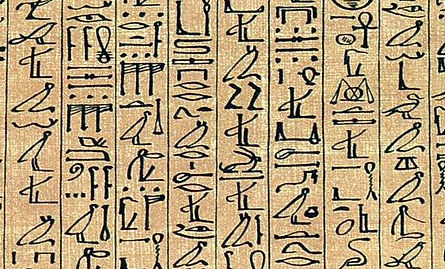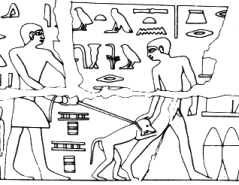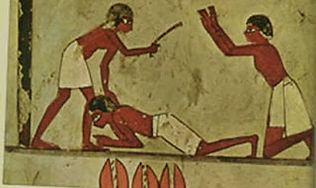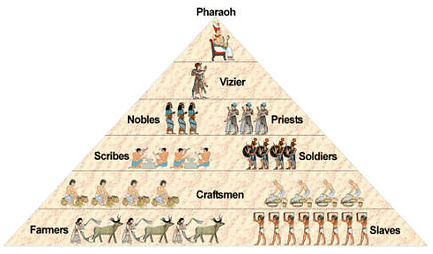



The Laws of Ancient Egypt
Just like todays society, Ancient Egypt had its own set of laws; their judicial system similar to what we believe to day. They based their law and their concept of justice on what was right and what was wrong. The Egyptians had believed that everyone was equal and they deserved to be judged equally; no matter what their social class was. Although this was not true, each social class was judged differently. They had police, criminal law, and civil law. This system helped Ancient Egypt to thrive and survive.
The justice system in ancient Egypt is very similar to today. In Ancient Egypt they had policemen. These policemen served to protect the people. “Armed with staffs, policemen guarded public places, at times making use of dogs or, probably more rarely, of trained monkeys” (anonymous, Law and Order, web). The police were also used to investigate crimes. “The prevention of crime and apprehension of criminals was the duty of local officials and police forces. They opened investigations following complaints by citizens. They collected clues against suspects by interrogating them and their acquaintances, checking public records, organizing reenactments and applying physical coercion, generally in the form of beatings” (anonymous, Law and Order, web).
They had civil law, the civil law helped peasants. This was a big deal as well because it showed that women also had rights. “Though males dominated the legal system in ancient Egypt, records indicate that females enjoyed considerable rights under the law. Upon an individual's death, property was often divided equally among both male and female children. Woman could own and bequeath property, file lawsuits, be witnesses in court and file for divorce. Children and the poor had considerable legal rights, and even slaves were allowed to own property under certain circumstances” (anonymous, Egypt: Law and the Legal System in Ancient Egypt, web).
The Ancient Egyptians also had criminal law. This was used to prosecute many people who stole, especially tomb robbers. There were many different types of punishment depending on what the crime was. Sometimes it was the pharaoh who determined the punishment or it would be someone he appointed. “That punishment for stolen or embezzled goods might be as simple as the return of the goods with a fine of twice their value. Simple corporal punishment could involve a hundred strokes of the cane and in more serious cases, 5 bleeding cuts added, or brands as a sign of permanent dishonor. The Pharaoh himself might very well decide the most important criminal cases, or at other times he might appoint a special commission with full authority to pass judgment. Depending on the severity of the case, being exiled to Nubia or the Western Oasis, or sent to labor in the distant mines or quarries was not uncommon. Some crimes were punished with mutilation consisting of cutting off a hand, tongue, nose or ears. In extreme cases, capital punishment was inflicted by implement on a stake, burning alive, drowning or decapitation. Because the guilty had violated Ma'at, it was also assumed the individual would suffer failure, poverty, sickness, blindness or deafness, with the final settlement a waiting in the Court of the Dead” (anonymous, Egypt: Law and the Legal System in Ancient Egypt, web).
Soon after all this, they began to write down all of their cases. They began to keep records to help in trials as well as for future reference. “The Egyptian obsession for keeping records was often useful against criminals. …Documents were generally composed by official scribes and the names of those who had witnessed the signing were appended. Witnesses gave testimony under oath” (anonymous, Law and Order, web). One of the most famous cases was written on papyrus that is now in a museum. “He trial record-perhaps the earliest complete record of a trial in history-survives on a papyrus document now in the British Museum, The document, which includes official notes and a record of both parties' testimony, comes from a small town (Asyut, in Middle Egypt) and dates to the middle of the second century B.C.E. Its complexities can only be briefly summarized here. The basis of the trial was a dispute that had arisen between two half-brothers over the ownership of family land” (Manning, The Representation of Justice in Ancient Egypt).
The laws of Ancient Egypt helped the people to solve disputes. It punished those who committed crime. The laws and justice system helped to dissolve disputes. It also proved that women had a voice. The records help to show what the system did to help these people.
Bibliography:
"Law and Order." Law and Order in Ancient Egypt. N.p., n.d. Web. 30 Nov. 2014.
"Tour Egypt :: Egypt: Law and the Legal System in Ancient Egypt." Egypt: Law and the Legal System in Ancient Egypt. N.p., n.d. Web. 29 Nov. 2014.
Manning, J.G. The Representation of Justice in Ancient Egypt 4th ser. 24.1 (2012): n. pag. Web. 30 Nov. 2014. <http://digitalcommons.law.yale.edu/cgi/viewcontent.cgi?article=1378&context=yjlh>.
I'm a paragraph. Click here to add your own text and edit me. I’m a great place for you to tell a story and let your users know a little more about you.


